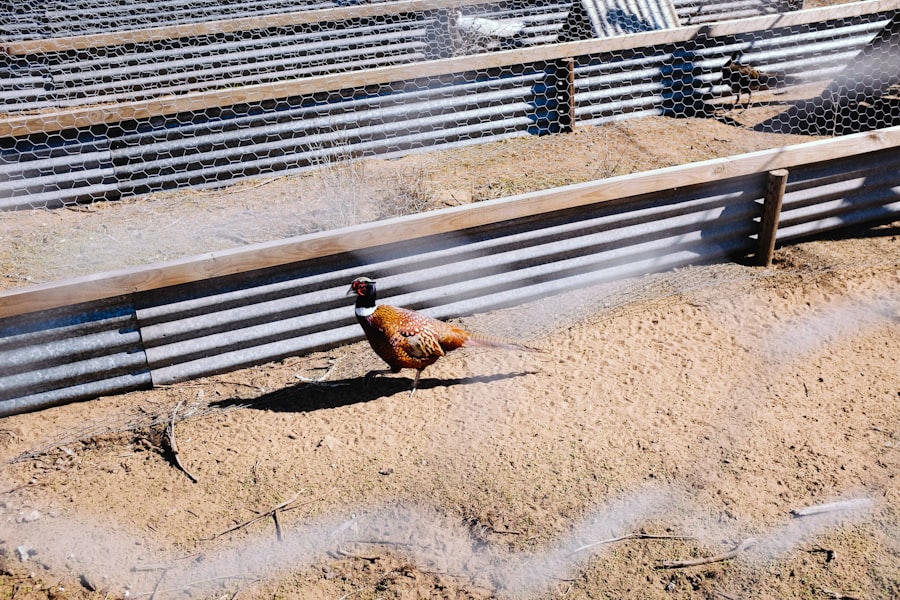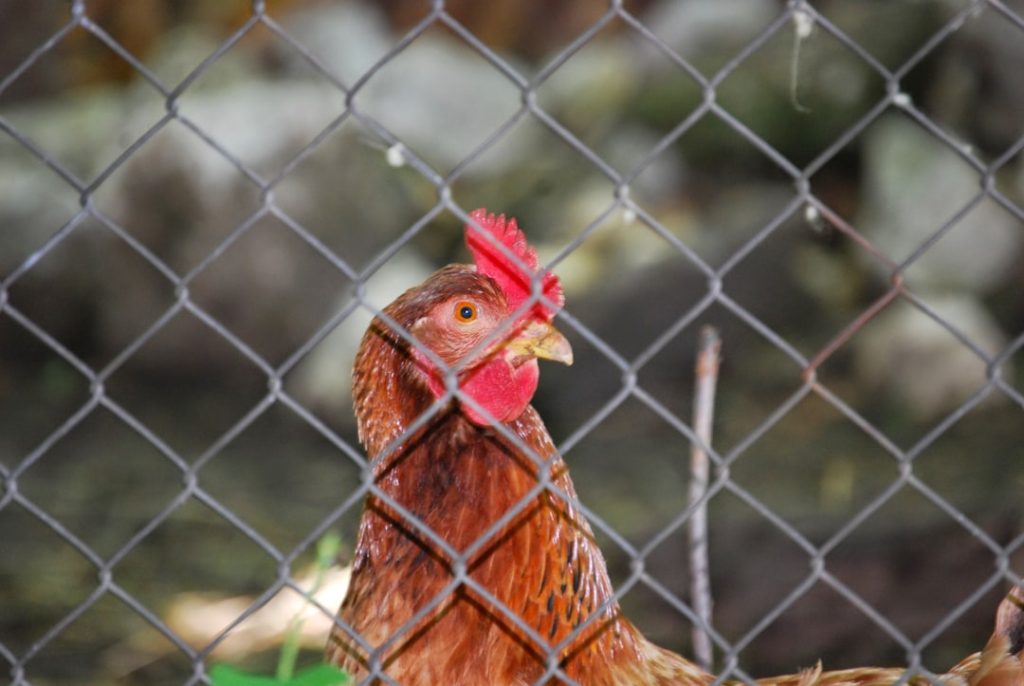Chickens are naturally curious and active animals, constantly pecking and scratching at the ground in search of food. They are excellent foragers, using their keen sense of sight and sound to detect potential threats and opportunities. Understanding these natural behaviors is crucial when managing chickens in a landscaping setting.
Recognizing their tendencies to scratch and peck helps anticipate where they may cause damage and allows for proactive preventive measures. Chickens are social animals that thrive in a flock environment, so providing them with appropriate space and enrichment is essential for their well-being. By understanding chicken behavior, a harmonious balance between their natural instincts and landscaping goals can be achieved.
Chickens have strong territorial instincts, often establishing specific areas for feeding, roosting, and dust bathing. This territorial behavior can lead to concentrated areas of damage in a landscape if not managed properly. Understanding the territorial nature of chickens allows for strategic planning and design of landscaping to minimize potential conflicts.
Chickens are diurnal animals, meaning they are most active during the day and rest at night. This knowledge can be used advantageously when implementing deterrents or alternative scratching areas to redirect their behavior. Overall, understanding chicken behavior is essential for creating a chicken-friendly landscaping environment that meets the needs of both the birds and the landscape.
Table of Contents
Key Takeaways
- Chickens are social animals and exhibit natural behaviors such as scratching, dust bathing, and foraging.
- When choosing mulch for chicken areas, opt for non-toxic options such as straw, wood chips, or shredded leaves.
- Install barriers such as fencing or chicken wire to keep chickens out of specific areas like gardens or flower beds.
- Create chicken-friendly landscaping by incorporating plants that are safe for chickens to peck at and providing shaded areas.
- Provide alternative scratching areas such as designated dirt patches or sandboxes to redirect chickens from sensitive areas.
- Implement deterrents like motion-activated sprinklers or noise devices to discourage chickens from certain areas.
- Regularly maintain and monitor chicken areas to ensure the effectiveness of barriers, landscaping, and deterrents.
Choosing the right type of mulch
Safety First: Non-Toxic Mulch Options
Some types of mulch, such as cocoa bean mulch, can be toxic to chickens if ingested. Therefore, it’s crucial to choose a non-toxic mulch option that won’t pose a risk to the birds.
Durability and Chicken Activity
Chickens are notorious for scratching and pecking at the ground, so a lightweight or easily scattered mulch may not be the best choice. Instead, opt for a heavier mulch that will stay in place and withstand the natural behaviors of the chickens.
Moisture Retention and Aesthetic Appeal
Chickens require access to dust bathing areas to maintain their health and hygiene, so selecting a mulch that retains moisture and provides a suitable dust bathing environment is essential. Additionally, consider the aesthetic appeal of the mulch and how it complements the overall landscaping design. Natural wood chips or straw mulch can provide a rustic and organic look that blends seamlessly with a chicken-friendly landscape. By carefully considering these factors, you can choose the right type of mulch that enhances the functionality and aesthetics of your chicken-friendly landscaping.
Installing barriers to keep chickens out

Installing barriers is an effective way to keep chickens out of specific areas within a landscaping design. Whether you want to protect delicate plants, flower beds, or vegetable gardens from chicken damage, barriers can provide a physical deterrent that prevents access. There are various types of barriers that can be used, including fencing, netting, and raised beds.
When selecting a barrier for your chicken-friendly landscaping, it’s important to consider the specific needs of your landscape and the behavior of your chickens. For example, if your chickens are avid flyers, a tall fence or netting may be necessary to prevent them from accessing certain areas. On the other hand, if your chickens are primarily ground-dwellers, raised beds or low fencing may be sufficient.
In addition to physical barriers, visual barriers can also be effective in deterring chickens from entering certain areas. Planting dense shrubs or creating natural barriers with landscaping features can obstruct the line of sight for chickens, making it less appealing for them to explore beyond certain boundaries. When installing barriers to keep chickens out, it’s important to ensure that they are secure and properly maintained.
Regularly inspecting and repairing barriers will help prevent any potential breaches that could allow chickens to access restricted areas. By strategically installing barriers that align with the behavior of your chickens, you can effectively protect your landscaping from unwanted damage.
Using chicken-friendly landscaping
Creating a chicken-friendly landscaping design involves incorporating elements that cater to the natural behaviors and needs of chickens. This can include providing suitable foraging areas, dust bathing spots, and roosting spaces within the landscape. By integrating these features into the design, you can encourage positive chicken behavior while minimizing potential damage to other areas of the landscape.
For example, incorporating designated foraging areas with loose soil or mulch can redirect the chickens’ natural scratching behavior away from delicate plants or flower beds. Similarly, providing designated dust bathing spots with fine sand or dust material can encourage chickens to engage in this essential hygiene behavior without disrupting other areas of the landscape. In addition to creating specific areas for chicken activities, it’s important to consider the layout and organization of the landscape to accommodate their needs.
This may involve creating pathways or open spaces that allow chickens to move freely without causing damage to more sensitive areas. By strategically planning the layout of your landscaping design, you can create a harmonious environment that meets the needs of both the chickens and the landscape. Furthermore, incorporating chicken-friendly landscaping elements can enhance the overall aesthetic appeal of the design, creating a cohesive and integrated space that balances functionality with visual appeal.
Providing alternative scratching areas
One effective strategy for managing chicken behavior in a landscaping setting is to provide alternative scratching areas that redirect their natural instincts away from sensitive areas. By offering designated scratching spots with loose soil or mulch, you can encourage chickens to focus their scratching behavior in specific locations rather than causing damage elsewhere in the landscape. These alternative scratching areas can be strategically placed in areas where chicken activity is less likely to cause harm, such as near compost piles or in open spaces away from delicate plants or flower beds.
By providing alternative scratching areas, you can effectively manage chicken behavior while preserving the integrity of your landscaping design. In addition to designated scratching spots, incorporating interactive elements such as hanging treats or toys can further engage chickens and redirect their attention away from sensitive areas. This not only provides enrichment for the birds but also helps mitigate potential damage to the landscape.
By offering stimulating activities and distractions, you can encourage positive chicken behavior while minimizing negative impacts on your landscaping. Furthermore, regularly refreshing and maintaining these alternative scratching areas will help ensure their effectiveness in managing chicken behavior over time. By providing alternative scratching areas and engaging activities, you can create a balanced environment that meets the needs of both the chickens and your landscaping goals.
Implementing deterrents to discourage chickens

Types of Deterrents
Visual deterrents such as scarecrows or reflective tape can startle chickens and discourage them from entering certain areas. Sound deterrents such as motion-activated alarms or clappers can also startle chickens and deter them from approaching sensitive parts of the landscape. Additionally, scent deterrents such as citrus peels or predator scents can create an unpleasant environment for chickens and discourage them from lingering in specific areas.
Effective Implementation
When implementing deterrents to discourage chickens, it’s important to regularly rotate and vary their placement to prevent habituation. Chickens are intelligent animals that can quickly adapt to static deterrents, so changing their location or type periodically can help maintain their effectiveness over time.
Customizing Deterrents to Your Chickens’ Needs
Additionally, it’s important to consider the specific needs and behaviors of your chickens when selecting deterrents. For example, if your chickens are particularly bold or persistent, you may need to use a combination of deterrents to effectively discourage them from accessing certain areas. By strategically implementing deterrents that align with the behavior of your chickens, you can protect your landscaping from unwanted damage while promoting positive chicken behavior.
Regular maintenance and monitoring
Regular maintenance and monitoring are essential components of managing chickens in a landscaping setting. By consistently inspecting and maintaining the landscape, you can identify potential issues or damage caused by chicken activity and take proactive measures to address them. This may involve repairing barriers, refreshing alternative scratching areas, or adjusting deterrents as needed.
Additionally, monitoring the behavior of your chickens within the landscape allows you to assess the effectiveness of your management strategies and make any necessary adjustments. In addition to regular maintenance and monitoring, it’s important to provide ongoing enrichment and stimulation for your chickens within the landscape. This can include introducing new interactive elements or rotating their access to different areas of the landscape to prevent boredom and reduce the likelihood of destructive behavior.
By actively engaging with your chickens and providing them with appropriate outlets for their natural instincts, you can create a balanced environment that promotes positive behavior while protecting your landscaping. Overall, regular maintenance and monitoring are crucial for creating a harmonious balance between chickens and landscaping. By staying proactive and attentive to the needs of both the birds and the landscape, you can effectively manage chicken behavior while preserving the integrity of your outdoor space.
If you’re looking for tips on how to keep chickens from scattering mulch, you might also be interested in learning about the best heater for a chicken coop. Check out this article for helpful information on keeping your chickens warm and comfortable during the colder months.
FAQs
What is mulch and why do chickens scatter it?
Mulch is a layer of material, such as wood chips, straw, or leaves, that is spread over the soil to retain moisture, suppress weeds, and improve soil health. Chickens may scatter mulch while foraging for insects, scratching the ground, or dust bathing.
How can I keep chickens from scattering mulch?
There are several methods to keep chickens from scattering mulch, including using barriers such as fencing or netting, providing designated foraging areas away from mulched areas, and using heavier mulch materials that are more difficult for chickens to move.
What are some chicken-friendly mulch alternatives?
Some chicken-friendly mulch alternatives include pine straw, shredded bark, and large wood chips. These materials are less likely to be scattered by chickens and can still provide the benefits of mulch for the garden.
Are there any plants or materials that can deter chickens from mulched areas?
Plants with strong scents, such as lavender or mint, can help deter chickens from mulched areas. Additionally, placing rocks or large branches on top of the mulch can make it more difficult for chickens to scatter.
Meet Walter, the feathered-friend fanatic of Florida! Nestled in the sunshine state, Walter struts through life with his feathered companions, clucking his way to happiness. With a coop that’s fancier than a five-star hotel, he’s the Don Juan of the chicken world. When he’s not teaching his hens to do the cha-cha, you’ll find him in a heated debate with his prized rooster, Sir Clucks-a-Lot. Walter’s poultry passion is no yolk; he’s the sunny-side-up guy you never knew you needed in your flock of friends!







